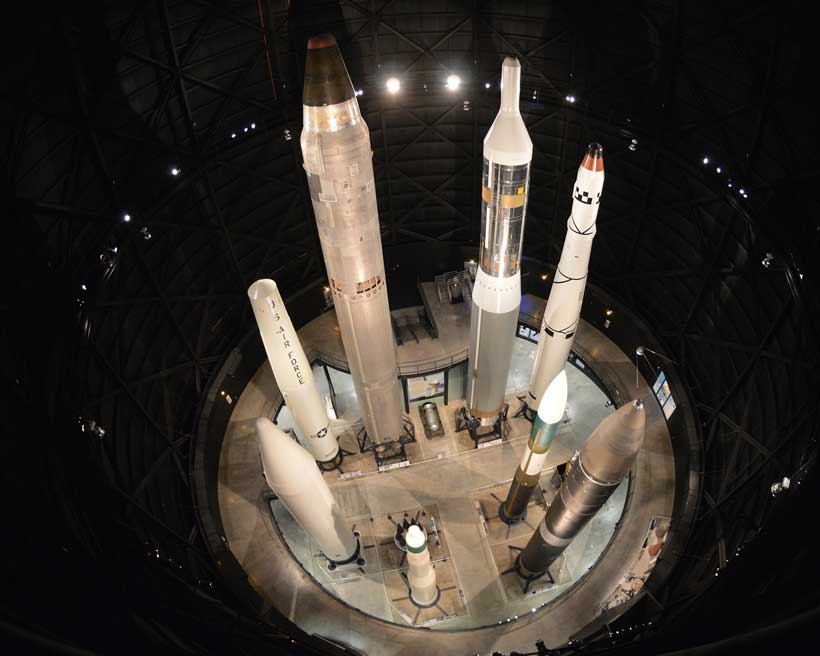Abstract: Whether by design or inadvertence – by “bolt-from-the-blue” attacks or incremental aggressions – certain states could find themselves embroiled in a nuclear war. To stave off such an unprecedented circumstance, the United States and various allies should understand that viable strategies of nuclear war avoidance need to rest on appropriate intellectual foundations. An overriding distinction should concern presumptively vital differences between madness and sanity in nuclear deterrence. In principle, a particular state’s resort to pretended madness could be sane and rational, but still pose grave risks during struggles for “escalation dominance.” Inter alia, in any crisis between enemy states in which one or both adversaries are already nuclear, a rational participant would seek to manage escalation without incurring unacceptable war risks. Non-rational adversaries would be more-or-less unpredictable, but genuinely mad adversaries would be inherently unpredictable. Though Euripides’ ancient declaration identifies madness as divine punishment (“Whom the Gods would destroy, they first make mad.”), the future of catastrophic warfare points to sanity as a potentially greater liability. This ironic assessment does not suggest that madness is “better” than sanity in world politics, but that the gravest portents of a nuclear war lie latent in leadership miscalculations, leadership under-estimations, computer malfunctions, command-control failures, unauthorized launch orders and nuclear weapon accidents.
Facing nuclear war
Since the United States atomic bombing of Hiroshima on August 6, 1945, humankind has been acquainted with new meanings of catastrophic conflict and “total war.” Until now, however, before Russian aggressions against Ukraine and prospective Iranian wars against Israel, the tangible portents of a “final epidemic”[1] have seemed more-or-less manageable. What next?
Russia has long been a nuclear power and Iran is nearing an operational nuclear capability. More to the point: (1) Russia’s core enemy remains the United States, not Ukraine; and (2) Iran, with expanding ties to Russia, China and North Korea, has repeatedly declared genocidal intentions toward Israel.[2] Though Israel is already nuclear,[3] it is less than half the size of America’s Lake Michigan. Israel is a state with no “strategic depth.”
There are multiple details to consider in any assessment of madness and world politics. Today, with steadily-growing strategic uncertainties surrounding Russian crimes against peace[4] and related Nuremberg-category crimes,[5] it’s high time to re-examine pertinent risks. As to identifying appropriate systemic contexts for such consideration, the current cycle of superpower conflict could become bewilderingly complex. For one thing, the continuously changing iterations of “Cold War II” could center on escalating conflicts involving China, India or Pakistan.
Certain primary and subsidiary distinctions should be raised at the outset. One such distinction concerns tangibly vital differences between deliberate or intentional nuclear war and a war that is unintentional or inadvertent. Without first considering these basic distinctions, little could be ascertained about the plausible likelihood of any Ukraine-triggered nuclear conflict. Nonetheless, the presumptively greatest dangers of an unintentional nuclear war would stem from hard to predict decision-making errors or miscalculations.
By definition, there exist serious logical and mathematical impediments to determinations of nuclear war probability. Because there has never been an authentic nuclear war (Hiroshima and Nagasaki don’t “count,” as they represent singular atomic attacks during an otherwise conventional war), determining future nuclear war probabilities must remain a preeminently subjective task.[6] Always, in science, true probabilities must derive from the determinable frequency of pertinent past events. Ipso facto, when there are no such events, nothing meaningful about relevant “odds” could be stated with reliability.
Pertinent nuclear war scenarios
The principal objectives here are not all controversial. Prima facie, a nuclear war should be averted at all costs, and capable analysts should systematically calculate optimal strategies to meet this always overriding objective. Foreseeably, these strategies could compel the United States and its allies to downplay or diminish the palpable urgency of Russian crimes against humanity.[7]
Such troublesome but indispensable calculations will vary (among other things) according to presumedenemy intentions and the credibility of accident, hacking intrusion and/or decisional miscalculation. Taken together as cumulative categories of any potential nuclear threat, these three component risks of an unintentional nuclear war are most clearly described as “inadvertent.” Of necessity, any case of accidental nuclear war would be inadvertent. At the same time, not every inadvertent nuclear war would be the result of an accident.
But all of these examples represent complex elements of a single overall national security problem: nuclear war avoidance.
This basic problem should never be approached by American national security policy-makers as a narrowly political or tactical issue. Instead, informed by serious historical understanding and by optimally-refined analytic capacities, US military planners should remain continuously prepared to deal with a large variety of sometimes-intersecting explanatory factors. Under the best conditions of modern science, this broad variety will appear multi-dimensional and daunting. Still, it need not be perplexing or overwhelming.
There are additional particulars. The principal national security risks America faces as a nation are immediate and incremental. Either way, some of these risks are at least prospectively existential. Ipso facto, they deserve America’s most sincere and concentrated examination. Serious answers could never be discoverable in election-year political rhetoric. There could never be any discernibly coherent answers in the dissembling voices of anti-reason.
There will be more to mitigating the Russian nuclear threat over Ukraine. Principal hazards could best be understood in light of plausible or even just conceivable intersections between them. All such critical intersections are more-or-less likely (a conclusion necessarily based on calculable expectations of logical deduction, not on actual history) and could sometimes be “synergistic.”
Immediately, more closely focused American attention on determinable synergies should become this country’s vital analytic objective. In principle, relevant synergies could involve nuclear events in other parts of the world. For example, Iran could become operationally nuclear in the next few years, and find itself at war with an already-nuclear Israel. In this connection, recent agreements between Shiite Iran and Sunni Saudi Arabia could upset overall Middle East stability in several different and mutually reinforcing ways.
In dealing with growing nuclear war risks, no clarifying concept could prove more important than “synergy.” Synergistic interactions are those wherein the “whole” of any nuclear war risk effects must be greater than the simple sum of its “parts.” Unless such interactions are accurately assessed and evaluated in time, the United States could meaningfully underestimate the total impact of any contemplated nuclear superpower engagements. Significantly, the estimable consequences of such underestimations could defy investigative imaginations and post-war justifications.
What has already been learned?
There is an informed personal aspect to these commentaries about nuclear war avoidance. I have been publishing about difficult and related strategic issues for more than fifty years. After four years of doctoral study at Princeton in the late 1960s, long an intellectual center of American nuclear strategic thought (recall especially Albert Einstein and J. Robert Oppenheimer), I began to consider adding a modest personal contribution to an already evolving nuclear literatures. By the late 1970s, I was cautiously preparing a new manuscript on US nuclear strategy, and, by variously disciplined processes of correct inference, on corresponding risks of a nuclear war.
At that early stage of a still-emerging discipline, I was especially interested in US presidential authority to order the use of American nuclear weapons. Though the currently expanding hazards over Ukraine stem directly from Vladimir Putin’s crimes of aggression[8] and crimes against humanity,[9] an oft-overlooked hazard would be any synergistic interaction with US presidential error. America’s accelerating nuclear war hazards ought to center on the manifold uncertainties of Russian escalations (in the context of Cold War II, each side would necessarily seek “escalation dominance”[10]), but there are coinciding and potentially synergistic perils of US presidential miscalculation.
In the United States, presumptively reliable safeguards have been incorporated into all operational nuclear command/control decisions from “day one,” but these same safeguards could not be applied at the presidential level. Many years ago, in order to gather suitable policy clarifications, I reached out to retired General Maxwell D. Taylor, a former Chairman of the US Joint Chiefs of Staff. In reassuringly rapid response, General Taylor sent a comprehensive handwritten reply.[11] Dated 14 March 1976, the distinguished General’s detailed letter concluded ominously:”As to those dangers arising from an irrational American president, the only protection is not to elect one.”
I had never given any extended thought to this authoritative reply. Recently, however, during the problematic presidency of Donald J. Trump, General Taylor’s 1976 warning plainly took on substantially greater and more urgent meanings. Based on both ascertainable facts and logical derivations (technically called “entailments” in philosophy of science terminology) rather than wishful thinking, we should now reasonably assume that if an American President were ever to exhibit signs of emotional instability, irrationality or delusional behavior, he could still order the use of American nuclear weapons. He could do so officially, “legally” and without any expectations of nuclear chain-of-command “disobedience.” More worrisome, an American president – much like Russian president Vladimir Putin – could become emotionally unstable, irrational or delusional, but still not exhibit such troubling liabilities conspicuously.
What happens then? What if these transformations are “bilateral” (US and Russia simultaneously) and synergistic? It’s the time to ask the right questions.
Law and US national survival
A corollary question should come promptly to mind: What precise stance should be assumed by the National Command Authority (Secretary of Defense, Chairman of the Joint Chiefs of Staff, and several possible others) if it should ever decide to oppose an “inappropriate” presidential order to launch American nuclear weapons? Could the National Command Authority (NCA) “save the day” informally by acting in an impromptu or creatively ad hoc fashion? Or should indispensable preparatory steps already have been taken preemptively?
Should there already be in place certain credible and effective statutory measures to assess the ordering president’s reason and judgment, and, if needed, to countermand an inappropriate or wrongful presidential order?
Under US law, Article 1 (Congressional) war-declaring expectations of the Constitution aside, any presidential order to use nuclear weapons, whether by an apparently irrational president or by an apparently incapacitated one, would have to be obeyed. To do otherwise in such incomparably dire circumstances would be illegal on its face. Here, any chain-of-command disobedience would be impermissible.
There is more. In principle, at least, a US President could order the first use of American nuclear weapons even if this country were not under a specifically nuclear attack. Some further strategic and legal distinctions would need to be clarified between a nuclear “first use” and a nuclear “first strike.” These terms would not express merely minor distinctions.
What next? Where should the American polity and government go from here on such urgent national security decision-making issues? To begin, a coherent and comprehensive answer will need to be prepared for the following basic question:
If faced with any presidential order to use nuclear weapons, and not offered sufficiently appropriate corroborative evidence of any actually impending existential threat, would the National Command Authority (1) be willing to disobey, and (2) be capable of meaningfully enforcing such glaring disobedience?
In any such unprecedented crisis-decision circumstances, authoritative decisions could have to be made in a compressively time-urgent matter of minutes, not in hours or days. As far as any useful policy guidance from the past might be concerned, there could be no scientifically valid way to assess the true probabilities of possible outcomes. This is because all scientific judgments of probability – and whatever the salient issue or subject – must be based on recognizablypertinent past events.
In matters concerning nuclear war, of course, there are no pertinent past events. This is a fortunate absence, but still one that would stand in the way of rendering reliable decision-making predictions. The irony here is obvious and problematic. In any event, whatever the science-based obstacles, the optimal time to prepare for such incomparably vital US national security difficulties is now.
Possible synergies and “escalation dominance”
Regarding the immediately specific matter of Ukraine, the American president should take special care to avoid strategic postures that neglect potential synergies with corresponding Russian postures. As for any mutual search for “escalation dominance,” the single most important factor in US policy judgments would be the expected rationality of Vladimir Putin. Prima facie, if the Russian president could be expected to strike the US or a US ally with nuclear forces irrespective of any anticipated American counterstrikes, nuclear deterrence would cease to work. This means that enemy strikes could be expected even if Putin had understood that the US and/or its ally had “successfully” deployed nuclear weapons in survivable modes, that its nuclear weapons were capable of penetrating Russia’s active defenses and that American leaders were willing to retaliate.
The only predictable element of this strategic assessment must be nuclear warfare’s inherent unpredictability. Even under most favorable assumptions of enemy rationality, all leading decision-makers would have to concern themselves with variously dense or confused communications, miscalculations, errors in information, unauthorized uses of strategic weapons, mechanical, electrical or computer malfunctions and even poorly-recognized applications of cyber-defense/cyber-war.
In the paroxysmal aftermath of a nuclear conflict, opinedstrategist Herman Kahn in the early 1960s, “survivors might envy the dead.” This is the case whether the unprecedented catastrophe had been intentional or unintentional and whether it had been occasioned by base motives, miscalculation, computer error, hacking intrusion or weapon-system/weapon infrastructure accident. Whatever else may be determinable by America’s national security decision-makers, these individuals should understand that nuclear strategy is ahigh-stakes struggle against anti-reason.[12] Such struggle represents an intellectual challenge that must be met at absolutely all costs.
In addition to bewildering questions about Israel, Iran, North Korea, India and Pakistan, American planners will need to investigate core questions about (1) Vladimir Putin’s willingness to use nuclear weapons[13] in Ukraine,[14] and (2) the intersections/synergies between such willingness and US presidential miscalculation on nuclear decision-making. Even now, even as a grievously victimized Ukraine emerges as the most potentially worrisome site of superpower nuclear war, existential hazards could only be prevented, reduced or controlled by aptly disciplined forms of intellectual activity.[15] In all cases, growing risks of nuclear warfare should be blunted by logic, science and “reason,” not by visceral spasms of gratuitous virulence or personal rancor. Though ancient Greek playwright Euripides warned poetically, “Whom the Gods would destroy, they first make mad,”[16] it is more plausible that humankind would not receive fair warnings of impending nuclear destruction and that millions could be destroyed by nuclear weapons while their leaders remained entirely sane.
[1] This apt term was used as title of an important early book dealing with nuclear war dangers: Ruth Abrams and Susan Cullen, The Final Epidemic: Physicians and Scientists on Nuclear War (1981). The well-respected contributors to this sobering anthology were associated with two prominent scientific/medical organizations of the time: Physicians for Social Responsibility and International Physicians Against Nuclear War. The present writer, Louis Rene Beres, was an active member of both groups at Princeton and Purdue. For authoritative early accounts by this author of nuclear war effects, see: Louis René Beres, Apocalypse: Nuclear Catastrophe in World Politics (Chicago: University of Chicago Press, 1980); Louis René Beres, Mimicking Sisyphus: America’s Countervailing Nuclear Strategy (Lexington, Mass., Lexington Books, 1983); Louis René Beres, Reason and Realpolitik: U.S. Foreign Policy and World Order (Lexington, Mass., Lexington Books, 1984); and Louis René Beres, Security or Armageddon: Israel’s Nuclear Strategy (Lexington, Mass., Lexington Books, 1986). Most recently, by Professor Beres, see: Surviving Amid Chaos: Israel’s Nuclear Strategy (New York, Rowman & Littlefield, 2016; 2nd ed. 2018).
[2] . See Convention on the Prevention and Punishment of the Crime of Genocide, opened for signature, December 9, 1948, entered into force, January 12, 1951, 78 U.N.T.S. 277. Although the criminalizing aspect of international law that proscribes genocide‑like conduct may derive from a source other than the Genocide Convention (i.e. it may emerge from customary international law and be included in different international conventions), such conduct is dearly a crime under international law. Even where the conduct in question does not affect the interests of more than one state, it becomes an international crime whenever it constitutes an offense against the world community delicto jus gentium.
[3] See, by this author and the “Project Daniel Group,” Israel’s Strategic Future (a report for PM Ariel Sharon, 2004): http://www.acpr.org.il/ENGLISH-NATIV/03-ISSUE/daniel-3.htm
[4] In law, there are related issues here concerning the specific crime of aggression. See especially: RESOLUTION ON THE DEFINITION OF AGGRESSION, Dec. 14, 1974, U.N.G.A. Res. 3314 (XXIX), 29 U.N. GAOR, Supp. (No. 31) 142, U.N. Doc. A/9631, 1975, reprinted in 13 I.L.M. 710, 1974; and CHARTER OF THE UNITED NATIONS, Art. 51. Done at San Francisco, June 26, 1945. Entered into force for the United States, Oct. 24, 1945, 59 Stat. 1031, T.S. No. 993, Bevans 1153, 1976, Y.B.U.N. 1043.
[5] See AGREEMENT FOR THE PROSECUTION AND PUNISHMENT OF THE MAJOR WAR CRIMINALS OF THE EUROPEAN AXIS POWERS AND CHARTER OF THE INTERNATIONAL MILITARY TRIBUNAL. Done at London, August 8, 1945. Entered into force, August 8, 1945. For the United States, Sept. 10, 1945. 59 Stat. 1544, 82 U.N.T.S. 279. The principles of international law recognized by the Charter of the Nuremberg Tribunal and the judgment of the Tribunal were affirmed by the U.N. General Assembly as AFFIRMATION OF THE PRINCIPLES OF INTERNATIONAL LAW RECOGNIZED BY THE CHARTER OF THE NUREMBERG TRIBUNAL. Adopted by the U.N. General Assembly, Dec. 11, 1946. U.N.G.A. Res. 95 (I), U.N. Doc. A/236 (1946), at 1144. This AFFIRMATION OF THE PRINCIPLES OF INTERNATIONAL LAW RECOGNIZED BY THE CHARTER OF THE NUREMBERG TRIBUNAL (1946) was followed by General Assembly Resolution 177 (II), adopted November 21, 1947, directing the U.N. International Law Commission to “(a) Formulate the principles of international law recognized in the Charter of the Nuremberg Tribunal and in the judgment of the Tribunal, and (b) Prepare a draft code of offenses against the peace and security of mankind….” (See U.N. Doc. A/519, p. 112). The principles formulated are known as the PRINCIPLES OF INTERNATIONAL LAW RECOGNIZED IN THE CHARTER AND JUDGMENT OF THE NUREMBERG TRIBUNAL. Report of the International Law Commission, 2nd session, 1950, U.N. G.A.O.R. 5th session, Supp. No. 12, A/1316, p. 11.
[6] Under international law, the question of whether or not a formal “state of war” exists between states is generally ambiguous. Traditionally, it was held that a declaration of war was necessary before any true state of war could be said to exist. Hugo Grotius divided wars into declared wars, which were legal, and undeclared wars, which were not. (See Hugo Grotius, The Law of War and Peace, Bk. III, Chapters. III, IV, and XI.) By the start of the twentieth century, the position that war obtains only after a conclusive declaration of war by one of the parties was codified by Hague Convention III. This treaty stipulated that hostilities must never commence without a “previous and explicit warning” in the form of a declaration of war or an ultimatum. (See Hague Convention III Relative to the Opening of Hostilities, 1907, 3 NRGT, 3 series, 437, article 1.) Currently, declarations of war may be tantamount to admissions of international criminality, because of the express criminalization of aggression by authoritative international law, and it could therefore represent a clear jurisprudential absurdity to tie any true state of war to formal and prior declarations of belligerency. It follows that a state of war may now exist without any formal declarations, but only if there exists an actual armed conflict between two or more states, and/or at least one of these affected states considers itself “at war.”
[7] See by this writer, Professor Louis René Beres: https://www.jurist.org/commentary/2022/07/louis-rene-beres-international-law-genocide-human-rights/
[8] Under international law, states must judge every use of force twice: once with regard to the underlying right to wage war (jus ad bellum) and once with regard to the means used in actually conducting war (jus in bello). Following the Kellogg-Briand Pact of 1928 and the United Nations Charter, there can be no right of any kind to aggressive war. However, the long-standing customary right of post-attack self-defense remains codified at Article 51 of the UN Charter. Similarly, subject to conformance, inter alia, with jus in bello criteria, certain instances of humanitarian intervention and collective security operations may also be consistent with jus ad bellum. The law of war, the rules of jus in bello, comprise: (1) laws on weapons; (2) laws on warfare; and (3) humanitarian rules. Codified primarily at The Hague and Geneva Conventions, these rules attempt to bring discrimination, proportionality and military necessity into all belligerent calculations.
[9]Crimes against humanity are defined as “murder, extermination, enslavement, deportation, and other inhumane acts committed against any civilian population before or during a war; or persecutions on political, racial or religious grounds in execution of or in connection with any crime within the jurisdiction of the Tribunal, whether or not in violation of the domestic law of the country where perpetrated….” See Charter of the International Military Tribunal, Aug. 8, 1945, Art. 6(c), 59 Stat. 1544, 1547, 82 U.N.T.S. 279, 288
[10]On “escalation dominance,” see article by Professor Louis René Beres at The War Room, US Army War College, Pentagon: https://warroom.armywarcollege.edu/articles/nuclear-decision-making-and-nuclear-war-an-urgent-american-problem/
[11] General Taylor’s clarifying letter is reproduced at the end of this article.
[12] See Karl Jaspers, Reason and anti-Reason in our Time (1952). The German philosopher clarifies the “fog of the irrational” that bedeviled Germany in the 1930s and 1940s, and later, the United States during the Trump years. In a distillation of his conspicuously grand thought, Jaspers proclaimed: “Reason is confronted again and again with the fact of a mass of believers who have lost all ability to listen, who can absorb no logical argument and who hold unshakably fast to the Absurd as an unassailable presupposition….”
[13] This means tactical or theatre nuclear weapons, not strategic nuclear ordnance. In this connection, it should be borne in mind that Russia’s presumptive nuclear security posture treats tactical nuclear weapons as a “next point” on an historic continuum of “battlefield” options, not as an extraordinary escalatory “firebreak.” For Moscow, the truly critical firebreak is between conventional /theatre nuclear forces and strategic nuclear weapons. See, by this author, Louis René Beres: https://moderndiplomacy.eu/2024/06/08/american-and-russian-firebreaks-survival-risks-of-asymmetrical-nuclear-doctrine/
[14] Regarding Vladimir Putin’s legal responsibility for egregious crimes, the responsibility of leaders for pertinent harms under international law is never limited by official position, sovereign immunity or any requirement of direct personal involvement. On the principle of command responsibility, or respondeat superior, see: In re Yamashita, 327 U.S. 1 (1945); The High Command Case (The Trial of Wilhelm von Leeb) 12 LAW REPORTS OF TRIALS OF WAR CRIMINALS 1, 71 (United Nations War Crimes Commission Comp. 1949); see: Parks, COMMAND RESPONSIBILITY FOR WAR CRIMES, 62 MIL.L.REV. 1 (1973); O’Brien, THE LAW OF WAR, COMMAND RESPONSIBILITY AND VIETNAM, 60 GEO.L.J. 605 (1972); U.S. DEPT OF THE ARMY, ARMY SUBJECT SCHEDULE No. 27 – 1 (Geneva Conventions of 1949 and Hague Convention No. IV of 1907) 10 (1970). The direct individual responsibility of leaders for genocide and genocide-like crimes is unambiguous in view of the London Agreement, which denies defendants the protection of the Act of State defense. See AGREEMENT FOR THE PROSECUTION AND PUNISHMENT OF THE MAJOR WAR CRIMINALS OF THE EUROPEAN AXIS, Aug. 8, 1945, 59 Strat. 1544, E.A.S. No. 472, 82 U.N.T.S. 279, Art. 7. Under traditional international law, violations were the responsibility of the state, as a corporate actor, and not of the individual human decision-makers in government and in the military.
[15] Says Guillaume Apollinaire: “It must not be forgotten that it is perhaps more dangerous for a nation to allow itself to be conquered intellectually than by arms.” See: The New Spirit and the Poets, 1917.
[16] Strictly speaking, madness and irrationality are not the same thing in world politics or strategic assessment. To wit, an irrational national leader might still display a consistent and transitive ordering of preferences, but the genuinely mad national leader would have no such identifiable predilections. Se also, by this writer: Louis René Beres, https://moderndiplomacy.eu/2022/11/20/reason-and-anti-reason-in-moscow-psychiatric-determinants-of-cold-war-ii/
——————————
LOUIS RENÉ BERES (Ph.D., Princeton, 1971) is Emeritus Professor of International Law at Purdue. His twelfth and most recent book is Surviving Amid Chaos: Israel’s Nuclear Strategy (2016) (2nd ed., 2018) https://paw.princeton.edu/new-books/surviving-amid-chaos-israel%E2%80%99s-nuclear-strategy Some of his principal strategic writings have appeared in Harvard National Security Journal (Harvard Law School); International Security (Harvard University); Yale Global Online (Yale University); Oxford University Press (Oxford University); Oxford Yearbook of International Law (Oxford University Press); Parameters: Journal of the US Army War College (Pentagon); Special Warfare (Pentagon); Modern War Institute (Pentagon); The War Room (Pentagon); World Politics (Princeton); INSS (The Institute for National Security Studies)(Tel Aviv); Israel Defense (Tel Aviv); BESA Perspectives (Israel); International Journal of Intelligence and Counterintelligence; The Atlantic; The New York Times and the Bulletin of the Atomic Scientists.


























